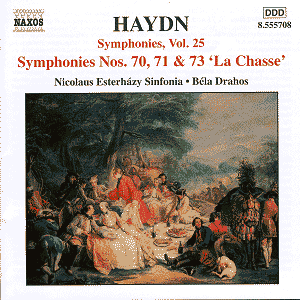The Naxos Haydn Symphonies project continues apace
with this interesting issue of three 'middle period' pieces, dating
from around 1780.
Haydn's famous observation that by being employed at
the Esterhazy establishment he was 'cut off, and therefore forced to
become original', is justified again and again by greater contact with
his music. For each of his symphonies at once has the hallmark of his
style and its own individual characteristics and personality.
Symphony No. 70 was one of the first works Haydn composed
after the disastrous Esterhaza fire of 1779, which among other things
destroyed the Prince's new theatre. The music is notable for the skilful
integration of the orchestral parts, including perhaps the most sophisticated
writing for trumpets that the composer had achieved thus far. The first
movement is brief and fiery, with jagged angular themes, but Drahos
is only moderately successful in generating intensity, both the phrasing
and the orchestral balances could have a more cutting edge than this.
Perhaps this is one of those occasions when the listener cannot be sure
whether it is the recording or the performance which misses fire.
The slow movement is another matter, however, since
the playing has real gracefulness and style. So too the insistent repetitions
of the note D which generate practically everything in the finale; this
is a highly idiomatic account.
Symphony No. 71 uses a smaller orchestra, without trumpets
and drums, but it does not lack imagination. There is a particularly
good slow introduction, attempting the same rhythm in different presentations,
before the lively Allegro con brio sets in. The Adagio is an extended
movement, a theme and variations, and this generally restrained movement
requires rather more point and colour in the recorded sound than is
found here. The performance has a certain opaque quality. The minuet
which follows makes a more direct impression, and all praise to the
string players for their dexterity in the whirlwind finale.
Among this collection of symphonies No. 73, 'La Chasse',
is the jewel in the crown. It is undeniable that the acquisition of
a nickname aids the popularity of a Haydn symphony, but in the case
the quality of imagination and invention have surely played their part
too. There is a problem of authenticity with this piece, since the overture
to Haydn's opera La fedelta premiata was added to the existing three
movements by way of finale, and employed trumpets, whereas these movements
did not. Some modern editions recommend adding trumpets throughout,
but this performance does not. The effect, taking the symphony as a
whole, makes for an unusual and distinctive listening experience, and
all praise to Naxos for mentioning the details of this in the accompanying
booklet note. In the bargain market they set the standard in this regard.
Drahos directs an engaging and energetic performance,
and finale sounds truly climactic, with genuine hunting fanfares which
allow the horns to provide the springboard to music of real vigour.
Terry Barfoot


